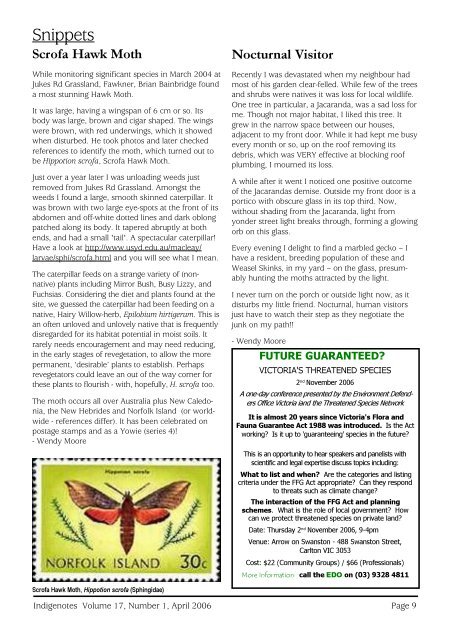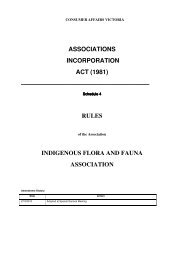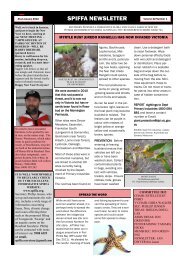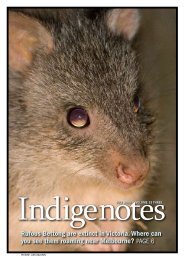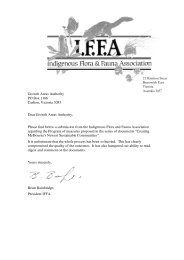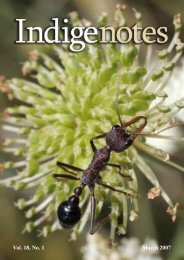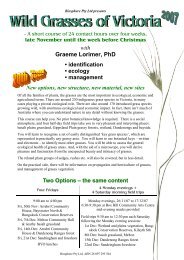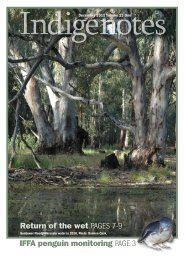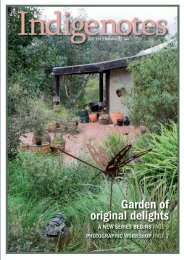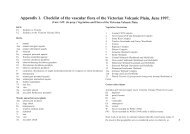Vol. 17, No. 2 September 2006 - Indigenous Flora and Fauna ...
Vol. 17, No. 2 September 2006 - Indigenous Flora and Fauna ...
Vol. 17, No. 2 September 2006 - Indigenous Flora and Fauna ...
You also want an ePaper? Increase the reach of your titles
YUMPU automatically turns print PDFs into web optimized ePapers that Google loves.
Snippets<br />
Scrofa Hawk Moth<br />
While monitoring significant species in March 2004 at<br />
Jukes Rd Grassl<strong>and</strong>, Fawkner, Brian Bainbridge found<br />
a most stunning Hawk Moth.<br />
It was large, having a wingspan of 6 cm or so. Its<br />
body was large, brown <strong>and</strong> cigar shaped. The wings<br />
were brown, with red underwings, which it showed<br />
when disturbed. He took photos <strong>and</strong> later checked<br />
references to identify the moth, which turned out to<br />
be Hippotion scrofa, Scrofa Hawk Moth.<br />
Just over a year later I was unloading weeds just<br />
removed from Jukes Rd Grassl<strong>and</strong>. Amongst the<br />
weeds I found a large, smooth skinned caterpillar. It<br />
was brown with two large eye-spots at the front of its<br />
abdomen <strong>and</strong> off-white dotted lines <strong>and</strong> dark oblong<br />
patched along its body. It tapered abruptly at both<br />
ends, <strong>and</strong> had a small 'tail'. A spectacular caterpillar!<br />
Have a look at http://www.usyd.edu.au/macleay/<br />
larvae/sphi/scrofa.html <strong>and</strong> you will see what I mean.<br />
The caterpillar feeds on a strange variety of (nonnative)<br />
plants including Mirror Bush, Busy Lizzy, <strong>and</strong><br />
Fuchsias. Considering the diet <strong>and</strong> plants found at the<br />
site, we guessed the caterpillar had been feeding on a<br />
native, Hairy Willow-herb, Epilobium hirtigerum. This is<br />
an often unloved <strong>and</strong> unlovely native that is frequently<br />
disregarded for its habitat potential in moist soils. It<br />
rarely needs encouragement <strong>and</strong> may need reducing,<br />
in the early stages of revegetation, to allow the more<br />
permanent, ‘desirable’ plants to establish. Perhaps<br />
revegetators could leave an out of the way corner for<br />
these plants to flourish - with, hopefully, H. scrofa too.<br />
The moth occurs all over Australia plus New Caledonia,<br />
the New Hebrides <strong>and</strong> <strong>No</strong>rfolk Isl<strong>and</strong> (or worldwide<br />
- references differ). It has been celebrated on<br />
postage stamps <strong>and</strong> as a Yowie (series 4)!<br />
- Wendy Moore<br />
<strong>No</strong>cturnal Visitor<br />
Recently I was devastated when my neighbour had<br />
most of his garden clear-felled. While few of the trees<br />
<strong>and</strong> shrubs were natives it was loss for local wildlife.<br />
One tree in particular, a Jacar<strong>and</strong>a, was a sad loss for<br />
me. Though not major habitat, I liked this tree. It<br />
grew in the narrow space between our houses,<br />
adjacent to my front door. While it had kept me busy<br />
every month or so, up on the roof removing its<br />
debris, which was VERY effective at blocking roof<br />
plumbing, I mourned its loss.<br />
A while after it went I noticed one positive outcome<br />
of the Jacar<strong>and</strong>as demise. Outside my front door is a<br />
portico with obscure glass in its top third. <strong>No</strong>w,<br />
without shading from the Jacar<strong>and</strong>a, light from<br />
yonder street light breaks through, forming a glowing<br />
orb on this glass.<br />
Every evening I delight to find a marbled gecko – I<br />
have a resident, breeding population of these <strong>and</strong><br />
Weasel Skinks, in my yard – on the glass, presumably<br />
hunting the moths attracted by the light.<br />
I never turn on the porch or outside light now, as it<br />
disturbs my little friend. <strong>No</strong>cturnal, human visitors<br />
just have to watch their step as they negotiate the<br />
junk on my path!!<br />
- Wendy Moore<br />
FUTURE GUARANTEED?<br />
VICTORIA'S THREATENED SPECIES<br />
2 nd <strong>No</strong>vember <strong>2006</strong><br />
A one-day conference presented by the Environment Defenders<br />
Office Victoria i<strong>and</strong> the Threatened Species Network<br />
It is almost 20 years since Victoria's <strong>Flora</strong> <strong>and</strong><br />
<strong>Fauna</strong> Guarantee Act 1988 was introduced. Is the Act<br />
working? Is it up to 'guaranteeing' species in the future?<br />
This is an opportunity to hear speakers <strong>and</strong> panelists with<br />
scientific <strong>and</strong> legal expertise discuss topics including:<br />
What to list <strong>and</strong> when? Are the categories <strong>and</strong> listing<br />
criteria under the FFG Act appropriate? Can they respond<br />
to threats such as climate change?<br />
The interaction of the FFG Act <strong>and</strong> planning<br />
schemes. What is the role of local government? How<br />
can we protect threatened species on private l<strong>and</strong>?<br />
Date: Thursday 2 nd <strong>No</strong>vember <strong>2006</strong>, 9-4pm<br />
Venue: Arrow on Swanston - 488 Swanston Street,<br />
Carlton VIC 3053<br />
Cost: $22 (Community Groups) / $66 (Professionals)<br />
More Information: call the EDO on (03) 9328 4811<br />
Scrofa Hawk Moth, Hippotion scrofa (Sphingidae)<br />
Indigenotes <strong>Vol</strong>ume <strong>17</strong>, Number 1, April <strong>2006</strong><br />
Page 9


